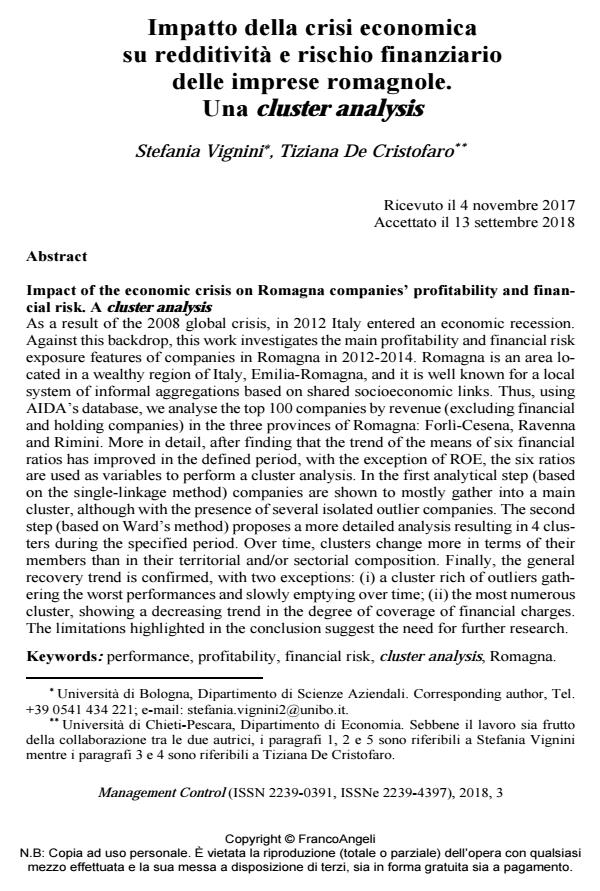Impatto della crisi economica su redditività e rischio finanziario delle imprese romagnole. Una cluster analysis
Titolo Rivista MANAGEMENT CONTROL
Autori/Curatori Stefania Vignini, Tiziana De Cristofaro
Anno di pubblicazione 2018 Fascicolo 2018/3
Lingua Italiano Numero pagine 25 P. 157-181 Dimensione file 313 KB
DOI 10.3280/MACO2018-003008
Il DOI è il codice a barre della proprietà intellettuale: per saperne di più
clicca qui
Qui sotto puoi vedere in anteprima la prima pagina di questo articolo.
Se questo articolo ti interessa, lo puoi acquistare (e scaricare in formato pdf) seguendo le facili indicazioni per acquistare il download credit. Acquista Download Credits per scaricare questo Articolo in formato PDF

FrancoAngeli è membro della Publishers International Linking Association, Inc (PILA)associazione indipendente e non profit per facilitare (attraverso i servizi tecnologici implementati da CrossRef.org) l’accesso degli studiosi ai contenuti digitali nelle pubblicazioni professionali e scientifiche
As a result of the 2008 global crisis, in 2012 Italy entered an economic recession. Against this backdrop, this work investigates the main profitability and financial risk exposure features of companies in Romagna in 2012-2014. Romagna is an area located in a wealthy region of Italy, Emilia-Romagna, and it is well known for a local system of informal aggregations based on shared socioeconomic links. Thus, using AIDA’s database, we analyse the top 100 companies by revenue (excluding financial and holding companies) in the three provinces of Romagna: Forlì-Cesena, Ravenna and Rimini. More in detail, after finding that the trend of the means of six financial ratios has improved in the defined period, with the exception of ROE, the six ratios are used as variables to perform a cluster analysis. In the first analytical step (based on the single-linkage method) companies are shown to mostly gather into a main cluster, although with the presence of several isolated outlier companies. The second step (based on Ward’s method) proposes a more detailed analysis resulting in 4 clusters during the specified period. Over time, clusters change more in terms of their members than in their territorial and/or sectorial composition. Finally, the general recovery trend is confirmed, with two exceptions: (i) a cluster rich of outliers gathering the worst performances and slowly emptying over time; (ii) the most numerous cluster, showing a decreasing trend in the degree of coverage of financial charges. The limitations highlighted in the conclusion suggest the need for further research.
Parole chiave:Performance, profitability, financial risk, cluster analysis, Romagna.
Stefania Vignini, Tiziana De Cristofaro, Impatto della crisi economica su redditività e rischio finanziario delle imprese romagnole. Una cluster analysis in "MANAGEMENT CONTROL" 3/2018, pp 157-181, DOI: 10.3280/MACO2018-003008